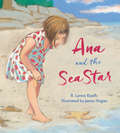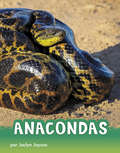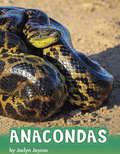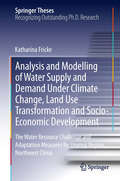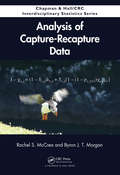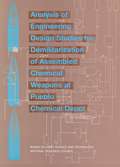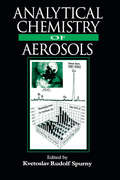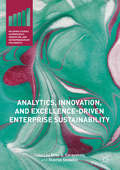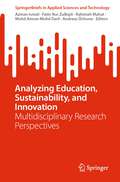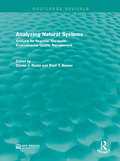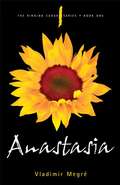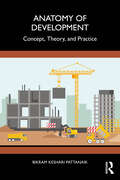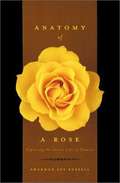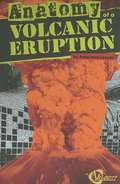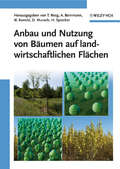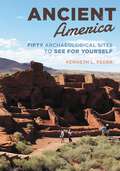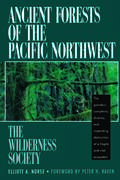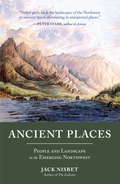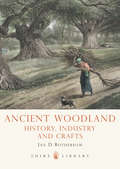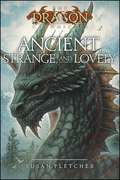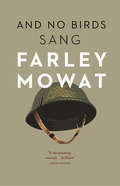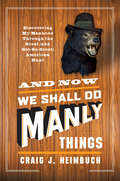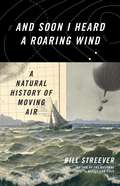- Table View
- List View
Ana and the Sea Star (Tilbury House Nature Book #0)
by Jamie Hogan R. Lynne RoelfsThis beautiful picture book celebrates the power of imagination and an appreciation of the natural world. A young girl finds a starfish on the beach and wants to show it to her mother at home, but doesn’t want to take it from its home. With encouragement from her dad and a little imagination, Ana is able to let the sea star go and yet keep it with her at the same time. This beautiful picture book celebrates the power of imagination and an appreciation of the natural world. Back matter invites children into the lives and experiences of a jellyfish, stingray, loggerhead turtle and other sea creatures. “The sea star waited as the sand settled around it. Then slowly, slowly it crept home to the sea grass meadow on hundreds of tiny tube feet.” “Ana watched a snowy plover grab its dinner from the surf. Then the tiny bird skittered across the sand. Ana and Papa followed their shadows home.” Fountas & Pinnell Level M
Anacondas (Animals en espanol)
by Jaclyn Jaycox¡Las anacondas son las serpientes ma´s grandes del mundo! Estas enormes criaturas estrujan a sus presas hasta asfixiarlas. Algunas son tan largas como un autobu´s y son capaces de estar bajo el agua por mucho tiempo mientras cazan. Desli´zate por las pa´ginas y aprende sobre estas poderosas serpientes.
Anacondas (Animals)
by Jaclyn JaycoxAnacondas are the heaviest snakes in the world! These big snakes use their bodies to squeeze their prey. Anacondas can be as long as a bus and can stay underwater for a long time while hunting. Slither towards the facts on these powerful snakes. <P><P><i>Advisory: Bookshare has learned that this book offers only partial accessibility. We have kept it in the collection because it is useful for some of our members. Benetech is actively working on projects to improve accessibility issues such as these.</i>
Analysis and Modelling of Water Supply and Demand Under Climate Change, Land Use Transformation and Socio-Economic Development: The Water Resource Challenge and Adaptation Measures for Urumqi Region, Northwest China (Springer Theses)
by Katharina FrickeLocated in a narrow grassland corridor between the semi-desert and a mountain range in Northwest China, the research area Urumqi Region is despite its semi-arid climate in a relatively favourable hydrological situation. The nearby mountains provide water for settlements and agriculture, making human development possible in the first place. Due to the development of agriculture, population and economy during the last sixty years and the increasing water consumption, a demand- and population-driven water scarcity exists today and is expected to aggravate. At the same time, the effects of climate change and land use transformations on the hydrological system and the water availability are uncertain. This study evaluates the recent and future situation by combining a hydrological water balance model for the simulation of the water supply based on scenarios of climate and land use change with a socio-economic model for projecting the future water demand including predicted growth of population and economy.
Analysis of Capture-Recapture Data (Chapman & Hall/CRC Interdisciplinary Statistics)
by Rachel S. McCrea Byron J. MorganAn important first step in studying the demography of wild animals is to identify the animals uniquely through applying markings, such as rings, tags, and bands. Once the animals are encountered again, researchers can study different forms of capture-recapture data to estimate features, such as the mortality and size of the populations. Capture-rec
Analysis of Engineering Design Studies for Demilitarization of Assembled Chemical Weapons at Pueblo Chemical Depot
by National Research Council Board on Army Science and Technology Division on Engineering and Physical Sciences Committee on Review and Evaluation of Alternative Technologies for the Demilitarization of Assembled Chemical Weapons: Phase IIThe Program Manager for Assembled Chemical Weapons Assessment (PMACWA) of the Department of Defense (DOD) requested the National Research Council (NRC) to assess the engineering design studies (EDSs) developed by Parsons/Honeywell and General Atomics for a chemical demilitarization facility to completely dispose of the assembled chemical weapons at the Pueblo Chemical Depot in Pueblo, Colorado. To accomplish the task, the NRC formed the Committee on Review and Evaluation of Alternative Technologies for Demilitarization of Assembled Chemical Weapons: Phase II (ACW II Committee). This report presents the results of the committee's scientific and technical assessment, which will assist the Office of the Secretary of Defense in selecting the technology package for destroying the chemical munitions at Pueblo. The committee evaluated the engineering design packages proposed by the technology providers and the associated experimental studies that were performed to validate unproven unit operations. A significant part of the testing program involved expanding the technology base for the hydrolysis of energetic materials associated with assembled weapons. This process was a concern expressed by the Committee on Review and Evaluation of Alternative Technologies for Demilitarization of Assembled Chemical Weapons (ACW I Committee) in its original report in 1999 (NRC, 1999). The present study took place as the experimental studies were in progress. In some cases, tests for some of the supporting unit operations were not completed in time for the committee to incorporate results into its evaluation. In those cases, the committee identified and discussed potential problem areas in these operations. Based on its expertise and its aggressive data-gathering activities, the committee was able to conduct a comprehensive review of the test data that had been completed for the overall system design. This report summarizes the study.
Analytical Chemistry of Aerosols: Science and Technology
by Kvetoslav Rudolf SpurnyUntil the 1980s, researchers studied and measured only the physical properties of aerosols. Since the 80s, however, interest in the physicochemcal properties of aerosols has grown tremendously. Scientists in environmental hygiene, medicine, and toxicology have recognized the importance held by the chemical composition and properties of aerosols and the interactions of inhaled, "bad" aerosols.This book offers the first comprehensive treatment of modern aerosol analytical methods, sampling and separation procedures, and environmental applications, and offers critical reviews of the latest literature. This important field has developed rapidly in the last 15 years, but until now, no book effectively summarized or analyzed the existing research.Analytical Chemistry of Aerosols reviews procedures, techniques, and trends in the measurement and analysis of atmospheric aerosols. With contributions from acknowledged, international experts, the book discusses various methods of bulk analysis, single particle analysis, and the analysis of special aerosol systems, including fibrous and bacterial aerosols.
Analytics, Innovation, and Excellence-Driven Enterprise Sustainability (Palgrave Studies in Democracy, Innovation, and Entrepreneurship for Growth)
by Elias G. Carayannis Stavros SindakisThis book offers a unique view of how innovation and competitiveness improve when organizations establish alliances with partners who have strong capabilities and broad social capital, allowing them to create value and growth as well as technological knowledge and legitimacy through new knowledge resources. Organizational intelligence integrates the technology variable into production and business systems, establishing a basis to advance decision-making processes. When strategically integrated, these factors have the power to promote enterprise resilience, robustness, and sustainability. This book provides a unique perspective on how knowledge, information, and data analytics create opportunities and challenges for sustainable enterprise excellence. It also shows how the value of digital technology at both personal and industrial levels leads to new opportunities for creating experiences, processes, and organizational forms that fundamentally reshape organizations.
Analyzing Education, Sustainability, and Innovation: Multidisciplinary Research Perspectives (SpringerBriefs in Applied Sciences and Technology)
by Andreas Öchsner Azman Ismail Mohd Amran Mohd Daril Fatin Nur Zulkipli Rahimah MahatThis book describes a diverse array of studies unravelling the intricate interplay of education, sustainability, and organizational dynamics. From innovative teaching methodologies to sustainability trends and the pandemic's impact, this compendium offers a rich tapestry of insights. This book traverses through a compendium of studies that intricately dissect the synergy between education, sustainability, and organizational dynamics. This book is ideal for academics, practitioners, and curious minds seeking a deeper understanding of these vital contemporary forces.
Analyzing Natural Systems: Analysis for Regional Residuals-Environmental Quality Management (Routledge Revivals)
by Daniel J. Basta Blair T. BowerThis report was undertaken on local, regional, state and federal levels in the United States to analyse the impact residuals have on environmental quality and to emphasise the need for Residuals- Environmental quality management (REQM). Originally published in 1982, this study brings together information on approaches for analysing natural systems and which factors to consider when choosing an approach. This title will be of interest to students of environmental studies as well as professionals and policy makers.
Anastasia (The Ringing Cedars Series #1)
by Vladimir Megré John Woodsworth Leonid SharashkinYou are about to read some of the most shocking revelations to appear in thousands of years of human history - so significant that they are changing the course of our destiny and rocking scientific and religious circles to the core.
Anatomy of Development: Concept, Theory, and Practice
by Bikram PattanaikThis book details the fundamentals of development studies by adopting a multi-disciplinary approach. It presents a balanced mix of economic, social, political, cultural and administrative premises of development and analyzes its theoretical and practical dimensions. It also provides insight into the role of the stakeholders of development in different sectors.The volume provides a holistic understanding of development, effectively demonstrating how it differs from economic growth. Beginning with development theories, paradigms and actors involved in the development process, this book goes on to explain the concepts of development administration, development governance, development planning, development management and development communication. One of the fundamental components of the book is the elucidation of Development Theories – classical, neoclassical, developmental and heterodox theories essential to the discipline of “development”.This book will be useful to undergraduate and postgraduate students, researchers, teachers of development studies, economics, sociology, political science, and public administration. It will also be useful to administrators and development administration officials of state and central governments, planners, policymakers and people working in NGOs, in addition to corporate sector functionaries dealing with corporate social responsibilities and those handling developmental issues and challenges.
Anatomy of a Park: Essentials of Recreation Area Planning and Design (Third Edition)
by Donald J. MolnarThis book lays bare the essentials of park design. Although it may serve as an overview or refresher for park designers, this book is written primarily for nondesigners such as lay members of park boards, park directors and superintendents, recreation leaders, and anyone directly affected by what a designer proposes for the development of parklands.
Anatomy of a Rose: Exploring the Secret Life of Flowers
by Sharman Apt RussellCombining graceful writing with a scientist's clarity, Russell reveals that the science behind these intelligent plants--how they evolved, survive, heal--is even more awe-inspiring than their fleeting beauty.
Anatomy of a Volcanic Eruption
by Amie Jane LeavittDescribes volcanic eruptions, including their causes, prediction, and effects.
Anbau und Nutzung von Bäumen auf landwirtschaftlichen Flächen
by Heinrich Spiecker Werner Konold Tatjana Reeg Dieter Murach Albrecht BemmannMit Agrarholz in die Zukunft: Der Anbau von Bäumen als Nutzpflanzen ist nicht nur klimafreundlich, sondern auch profitabel! Die Intensivnutzung von Bäumen in der Landwirtschaft gewinnt immer mehr an Bedeutung. Steigende Öl- und Gaspreise machen Holz als Energieträger wirtschaftlich attraktiv und tragen gleichzeitig zum Klimaschutz bei. Die neuesten Erkenntnisse aus drei aktuellen Verbundprojekten (AGROFORST, AGROWOOD, DENDROM) werden für den Praktiker aufbereitet und alle Aspekte des Wirtschaftskreislaufs angesprochen: rechtliche Rahmenbedinungen, Hinweise zu Fördergeldern, Planung, Anlage und den Betrieb der Pflanzung, bis hin zur optimalen Vermarktung der Produkte. Neben betriebswirtschaftlichen Erwägungen steht die ökologische Gesamtbilanz dieser Form des Pflanzenbaus im Vordergrund, die auch den Flächenverbrauch und ein durch neu geschaffene "Baumfelder" verändertes Landschaftsbild mit einbezieht.
Ancient America: Fifty Archaeological Sites to See for Yourself
by Kenneth L FederVisit fifty amazing places highlighting indigenous peoples&’ art, engineering, and more in &“a thoroughly enjoyable guide to America&’s prehistory.&” ―American Archaeology Well-traveled anthropologist Kenneth Feder invites readers to explore the stunning technological, architectural, engineering, and artistic achievements of America&’s first peoples. Part travel guide, part friendly reference, Ancient America showcases fifty iconic and publicly accessible sites located across the contiguous United States, most in state and national parks—including monumental pyramids of earth, &“castles&” ensconced in cliff niches, and vast rock art galleries. Among the places profiled are: Four World Heritage Sites (Chaco Canyon, NM; Mesa Verde, CO; Cahokia, IL; Poverty Point, LA) Numerous Historic Landmarks and National Monuments (including Crystal River, FL; Town Creek Mound, NC; Casa Grande, AZ; and Hovenweep, UT) Stunningly diverse sites ranging from Serpent Mound (OH) and Horsethief Lake (WA) to Canyon de Chelly (AZ) and Nine Mile Canyon (UT) In addition to practical visitor information, Feder tells the fascinating stories of each site as revealed by archaeological research. Introductory chapters delve into the deep past of Native America; historical and cultural details as well as original photography round out the site entries. &“Sites are . . . ranked on a number of factors useful for visitors, including &‘Ease of Road Access,&’ &‘Natural Beauty,&’ &‘Kid Friendliness,&’ and the overall &‘Wow Factor.&’ . . . will inspire readers to visit places that will connect them to the early peoples of North America.&” ―Booklist
Ancient Forests of the Pacific Northwest
by Peter H. Raven The Wilderness Society Elliott A. NorseAncient Forests of the Pacific Northwest provides a global context for what is happening in the Pacific Northwest, analyzing the remaining ancient forest and the threats to it from atmospheric changes and logging. It shows how human tampering affects an ecosystem, and how the Pacific Northwest could become a model for sustainable forestry worldwide.
Ancient Places
by Jack NisbetThese are the genesis stories of a region. In Ancient Places, Jack Nisbet uncovers touchstones across the Pacific Northwest that reveal the symbiotic relationship of people and place in this corner of the world. From rural Oregon, where a controversy brewed over the provenance and ownership of a meteor, to the great floods 15,000 years ago that shaped what is now Washington, Oregon, and Idaho, this is a compelling collection of stories about the natural and human history of our region.
Ancient Woodland: History, Industry and Crafts
by Ian RotherhamCONTRARY TO POPULAR BELIEF, Britain's ancient woodlands are not 'wildwoods', or even remnants of 'wildwood'. These truly cultural landscapes mix nature and human history, woven as uniquely rich tapestries of ecology and history. The story of the woods is there to be 'read' if you have time, enthusiasm, and this book, which will take you from prehistory to the present day.
Ancient, Strange, and Lovely
by Susan FletcherIn a new dragon novel by Susan Fletcher, Bryn must save a dracling from a dangerous modern world that seems to have no place for an ancient dragon.
And No Birds Sang
by Farley MowatTurned away from the Royal Canadian Air Force for his apparent youth and frailty, Farley Mowat joined the infantry in 1940. The young second lieutenant soon earned the trust of the soldiers under his command, and was known to bend army rules to secure a stout drink, or find warm - if non-regulation - clothing. But when Mowat and his regiment engaged with elite German forces in the mountains of Sicily, the optimism of their early days as soldiers was replaced by despair. With a naturalist's eyes and ears, Mowat takes in the full dark depths of war - and his moving account of military service, and the friends he left behind, is also a plea for peace. It is one of the most searing and unforgettable World War II memoirs from any Canadian.
And Now We Shall Do Manly Things
by Craig HeimbuchCraig Heimbuch, urban dad, journalist, and editor-in-chief of manofthehouse.com offers readers a humorous exploration of hunting culture in And Now We Shall Do Manly Things. Outdoors enthusiasts, fans of A.J. Jacobs's The Know-It-All and the Bill Bryson classic, A Walk in the Woods will appreciate Heimbuch's aspirations to better understand the men in his family by immersing himself for one year in the manly art of hunting. A book that explores with great wit and open-hearted appreciation the ideal of traditional masculinity, And Now We Shall Do Manly Things demonstrates that it is possible to be both a hunter and a modern American man.
And Soon I Heard a Roaring Wind: A Natural History of Moving Air
by Bill StreeverA thrilling exploration of the science and history of wind from the bestselling author of Cold.Scientist and bestselling nature writer Bill Streever goes to any extreme to explore wind--the winds that built empires, the storms that wreck them--by traveling right through it. Narrating from a fifty-year-old sailboat, Streever leads readers through the world's first forecasts, Chaos Theory, and a future affected by climate change. Along the way, he shares stories of wind-riding spiders, wind-sculpted landscapes, wind-generated power, wind-tossed airplanes, and the uncomfortable interactions between wind and wars, drawing from natural science, history, business, travel, as well as from his own travels. AND SOON I HEARD A ROARING WIND is an effortless personal narrative featuring the keen observations, scientific rigor, and whimsy that readers love. You'll never see a breeze in the same light again.
And Then It Rained on Malcolm
by Paige FeurerEven when it’s pouring rain, Malcolm can’t bring himself to stay inside. He puts on his red boots and his red coat, pulls on his goggles, and heads out for an adventure. He splashes around the yard, jumps in puddles, and gets tickled by worms. But when Malcolm’s done playing he runs right through the mud and right through the sand--and right through the house! Mom’s not impressed. How is this silly boy going to fix his mess? Rich Farr’s energetic illustrations add the perfect touch of whimsy to Paige Feurer’s simple yet lively text. And Then It Rained on Malcolm is the perfect read-aloud book for even the squirmiest kids and is sure to get everyone giggling over Malcolm’s silly antics and his clever thinking. Enthusiastic lovers of Malcolm’s adventure might plead for permission to go outside the next time it rains--and even if they race through the house with muddy boots and dripping raincoats afterwards they’ll know how to clean up the mess!
